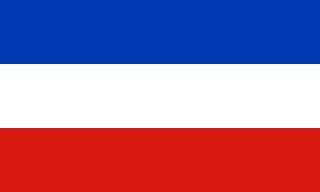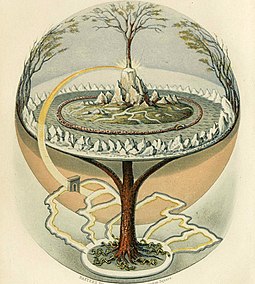
Freyr, sometimes anglicized as Frey, is a widely attested god associated with sacral kingship, virility and prosperity, with sunshine and fair weather, and pictured as a phallic fertility god in Norse mythology. Freyr is said to "bestow peace and pleasure on mortals". Freyr, sometimes referred to as Yngvi-Freyr, was especially associated with Sweden and seen as an ancestor of the Swedish royal house.

In Germanic mythology, Frigg, Frija, Frea (Langobardic), and Frige is a goddess. In nearly all sources, she is described as the wife of the god Odin. In Old High German and Old Norse sources, she is also connected with the goddess Fulla. The English weekday name Friday bears her name.

Völuspá is the first and best known poem of the Poetic Edda. It tells the story of the creation of the world and its coming end, related to the audience by a völva addressing Odin. It is one of the most important primary sources for the study of Norse mythology. Henry Adam Bellows proposed a 10th-century dating and authorship by a pagan Icelander with knowledge of Christianity. He also assumes the early hearers would have been very familiar with the "story" of the poem and not in need of an explanation.

In Norse mythology, the Vanir are a group of gods associated with fertility, wisdom, and the ability to see the future. The Vanir are one of two groups of gods and are the namesake of the location Vanaheimr. After the Æsir–Vanir War, the Vanir became a subgroup of the Æsir. Subsequently, members of the Vanir are sometimes also referred to as members of the Æsir.
In Norse mythology, Vanaheimr is one of the Nine Worlds and home of the Vanir, a group of gods associated with fertility, wisdom, and the ability to see the future.

In Norse mythology, Gullveig is a being who was speared by the Æsir, burnt three times, and yet thrice reborn. Upon her third rebirth, Gullveig's name becomes Heiðr and she is described as a knowledgeable and skillful völva. Gullveig/Heiðr is solely attested in the Poetic Edda, compiled in the 13th century from earlier traditional material. Scholars have variously proposed that Gullveig/Heiðr is the same figure as the goddess Freyja, that Gullveig's death may have been connected to corruption by way of gold among the Æsir, and/or that Gullveig's treatment by the Æsir may have led to the Æsir–Vanir War.

In Norse mythology, Kvasir was a being born of the saliva of the Æsir and the Vanir, two groups of gods. Extremely wise, Kvasir traveled far and wide, teaching and spreading knowledge. This continued until the dwarfs Fjalar and Galar killed Kvasir and drained him of his blood. The two mixed his blood with honey, resulting in the Mead of Poetry, a mead which imbues the drinker with skaldship and wisdom, and the spread of which eventually resulted in the introduction of poetry to mankind.
The orthography of the Old Norse language was diverse, being written in both Runic and Latin alphabets, with many spelling conventions, variant letterforms, and unique letters and signs. In modern times, scholars established a standardized spelling for the language. When Old Norse names are used in texts in other languages, modifications to this spelling are often made. In particular, the names of Old Norse mythological figures often have several different spellings.
Asgard is the realm of the gods in Norse mythology.
The Vættir of Norse myth are spirits. The term can be used to refer to the full Norse cosmos of supernatural beings, including the Álfar (elves), Dvergar (dwarves), Jötnar (giants), and gods. Vættir can also refer more specifically to Landvættir, Sjóvættir, vatnavættir, or Húsvættir
The Norse mythology, preserved in such ancient Icelandic texts as the Poetic Edda, the Prose Edda, and other lays and sagas, was little known outside Scandinavia until the 19th century. With the widespread publication of Norse myths and legends at this time, references to the Norse gods and heroes spread into European literary culture, especially in Scandinavia, Germany, and Britain. In the later 20th century, references to Norse mythology became common in science fiction and fantasy literature, role-playing games, and eventually other cultural products such as Japanese animation.

Quidi Vidi is a neighbourhood in St. John's, Newfoundland and Labrador. The neighbourhood is named for both Quidi Vidi Lake and Quidi Vidi Harbour - known locally as "The Gut". Located in Quidi Vidi is the Quidi Vidi Battery Provincial Historic Site, which had significance as a battery during the War of 1812. The village is also home to Newfoundland's largest microbrewery, the Quidi Vidi Brewing Company. It has many different types of plants and animals. There are numerous scenic places to visit.

The Valhalla Brewery in Unst, Shetland, Scotland, was the northernmost brewery in the United Kingdom. It was opened by the husband and wife team Sonny and Silvia Priest in December 1997, and originally based in a large shed in Baltasound, in the centre of Unst. In 2012 the brewery moved to a building at the former RAF Saxa Vord radar station, near Haroldswick. This larger premises allowed the brewery to double production to 144,000 litres a year.
Jason Todd Ipson is an American director, screenwriter, producer, fashion photographer and licensed physician and surgeon. Transitioning from surgical residency to the USC School of Cinematic Arts in 1999, he went on to form Asgaard Entertainment as well as write/direct the theatrically released feature films Unrest and Everybody Wants to be Italian.
Asgaard is a TV Azteca game show broadcast every Sunday at 7:00 pm on Azteca 13. The first broadcast was on July 27, 2008.

In Old Norse, seiðr was a type of sorcery practiced in Norse society during the Late Scandinavian Iron Age. The practice of seiðr is believed to be a form of magic relating to both the telling and shaping of the future. Connected with Norse religion, its origins are largely unknown, although it became gradually eroded following the Christianization of Scandinavia. Accounts of seiðr later made it into sagas and other literary sources, while further evidence has been unearthed by archaeologists. Various scholars have debated the nature of seiðr, some arguing that it was shamanic in context, involving visionary journeys by its practitioners.

The Kyrkogården Runestones are three Viking Age memorial runestones located at the cemetery of St. Mary's Church in Sigtuna, Stockholm County, Sweden, in the historic province of Uppland. One of the runic inscriptions documents the existence of a Viking Age mercantile guild in Sweden.
Asgaard Das Göttliche is a beer produced and marketed by the AsGaard Brauerei Schleswig in Germany. The beer is connected to Viking culture in its marketing and name, which is reference to Norse mythology of Asgaard, a realm of the gods of the Vikings, the Aesir, said to be known for their heavy beer consumption. These clans made settlement in Haitabu, which was one of the biggest trade cities in Northern Europe, and is situated near the modern German town of Schleswig, where brewmaster Ronald T. Carius opened the Asgaard brewery and pub in 1994.













